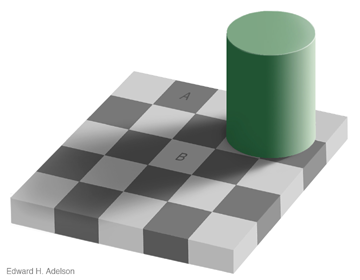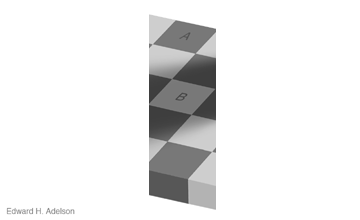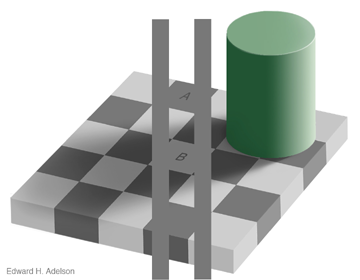Shades of gray
December 1st, 2006
Here’s an amazing thing: the squares marked A and B are the same shade of gray! Yes, that’s right. I’ll say it again more slowly: the darker-looking square marked A at the top of the board and the lighter-looking square marked B in the shadowy area are actually the same physical colour. Your monitor is displaying the same colour values in each area.
You can probably guess part of why the illusion works so well—we automatically adjust to counter the darkening due to the shadow —but the illusion continues working even when the green cylinder “causing” the shadow is cropped out:

This shows another part of why the illusion works; we make different assumptions about sharp edges than we do about gradients. The final picture should help you to see the truth of the claim that the squares are the same gray:

The illusion’s creator, Edward H Adelson, provides a more complete explanation.
It’s not new; I’ve been personally marvelling at it for a few years now. But familiarity doesn’t seem to defuse its effect. I consciously understand its workings, I can talk myself through it, but I just can’t make its reality seem intuitively present to me. It’s a fantastic optical illusion, but it’s also so much more; it’s a great scientific parable that illustrates key attributes of the way we think.
The first point is that much our thinking happens below the level of consciousness. Even what we perceive as being pure raw data about the world is the result of our automatic filtering and structuring of our sensory inputs. The world is real, but our knowledge of it is constructed, mediated by our minds. In a classier blog you’d get a quote from Kant here since he wrote about this in the eighteenth century, but I haven’t read him so you’ll have to do without.
The fact that this subconscious processing can be fooled in contrived situations doesn’t mean that it isn’t intelligent or useful. On the contrary, these heuristics usually do a fine job of building our model of the external world. In the instance illustrated above the colour adjustments act to give us a more stable view of the appearance of things, just as we intuitively learn that further objects are not actually smaller, or that they are not turning when we tilt our heads.
The assumptions these perceptual arrangements implicitly contain are, of course, appropriate to the situations typically experienced during their evolution. The further we get from these situations, the more likely it is that assumptions fail and our perception is tricked. Sometimes we can turn these perceptual mistakes to our advantage. In our evolutionary past, for instance, finding a flat image that contained a perspective view of the world would be exceptionally unlikely. So when we look at a realistic picture we are tricked into seeing “a world behind it”, rather than gaining a neutral view of the picture surface itself. It is this illusion that enables much art and photography and that sets us up for the checkerboard illusion above.
Optical illusions are fun and popular because it’s easy to lay plain both the illusion itself and the proof that it is an illusion. Cognitive illusions, however, are harder to show but are just as real. Similar to our preparation of optical sensory data is our automatic structuring of judgements on everything that just seems intuitive to us. These could be views on whom to trust or fear, what to eat or be disgusted by, or how safe or risky a venture is, for instance. Our assumptions about morality in particular seem especially close to us, and it is this closeness that suggests to me that the thinking underlying these attitudes is analogous to the visual processing above.
A key point is that we are not exclusively determined by our evolved nature. Quite the opposite is true, in fact; if we put our minds to it, if we carefully reason things through, we are able to consciously transcend our intuitions and distinguish the illusory from the truthful, just as we could above. The trouble is that this takes effort, and although it may be possible to create a reasoned argument for an alternative view, our subconscious primitive impulses may continue to nag at us, again, just as they do above.
Going with the flow is cognitively relaxing but lazy. It’s much easier to be interested in the views and opinions of beautiful people than of ugly ones. It’s much harder to trust people who’s appearance or behaviour differs from our own. It’s easy to find unfamiliar foods disgusting, unfamiliar music unlistenable, unfamiliar dance or social practice comical. We have evolved to hold dear the appearance and practices of those we grow up amongst, and to be suspicious of outsiders.
An awareness of these lazy tendencies is the first step in freeing ourselves from them and the remaining steps simply require holding an open mind, exploring beyond our comfort zones, and taking a calm, careful and reasoned view of what we find. This stance may sometimes be found in scientific or other academic writing, but it is almost by definition popularly seen as wrongheaded or difficult. Our tragedy is that it is therefore the very opposite of what the politicians and the media tend to feed to us.
February 8th, 2007 at 4:30pm
love the illusions–love the explanatory notes too..well written site..I am tagging you..
designmatters.wordpress.com
October 16th, 2007 at 9:19am
awesome. i like your explaining cognition topics
November 13th, 2007 at 9:46pm
Yup, all true from this p.o.v. anyway, ….have been considering the notion of ‘inter-subjective panopticons’ recently…phrase seemingly coined by Mark Kingwell, a fellow-oz-opher. He’s got plenty to say about how we ping and pong, and why, and with, and FOR whom. (A panopticon was a ‘prison design’ proposed by Jeremy Bentham back in the eighteenth century. Cells were built around a central surveillance tower. The guards were able to watch everything unbeknownst to the cellmates. Foucault (another fellow-oz-opher) started using the ‘noun’ to describe hierachies of power within ‘benign’ democracies…) How Kingwell morphed this notion into ‘an inter-subjective panopticon’ eludes still, but I THINK he means we’re all WATCHING as we’re DOING … thoughts always welcome, cheers, L